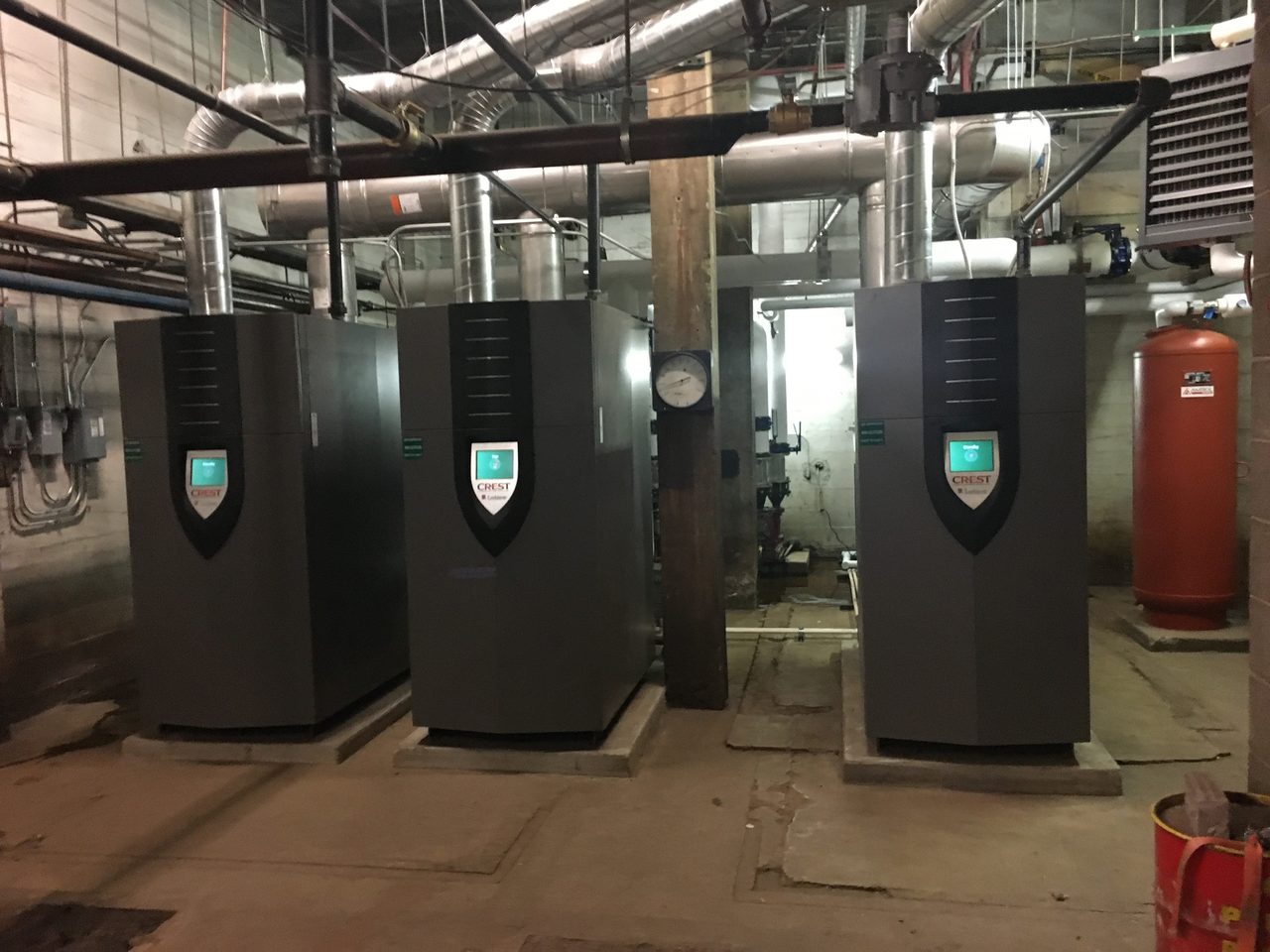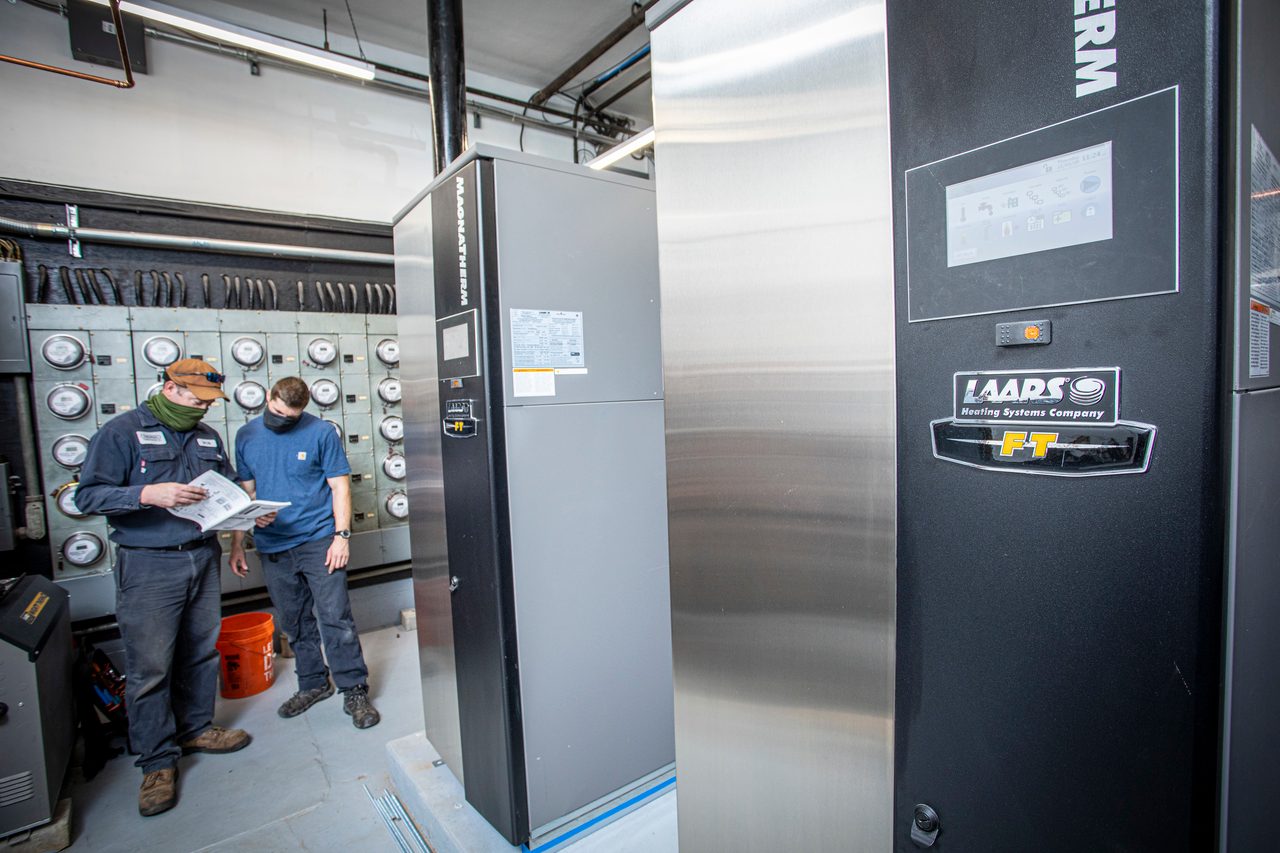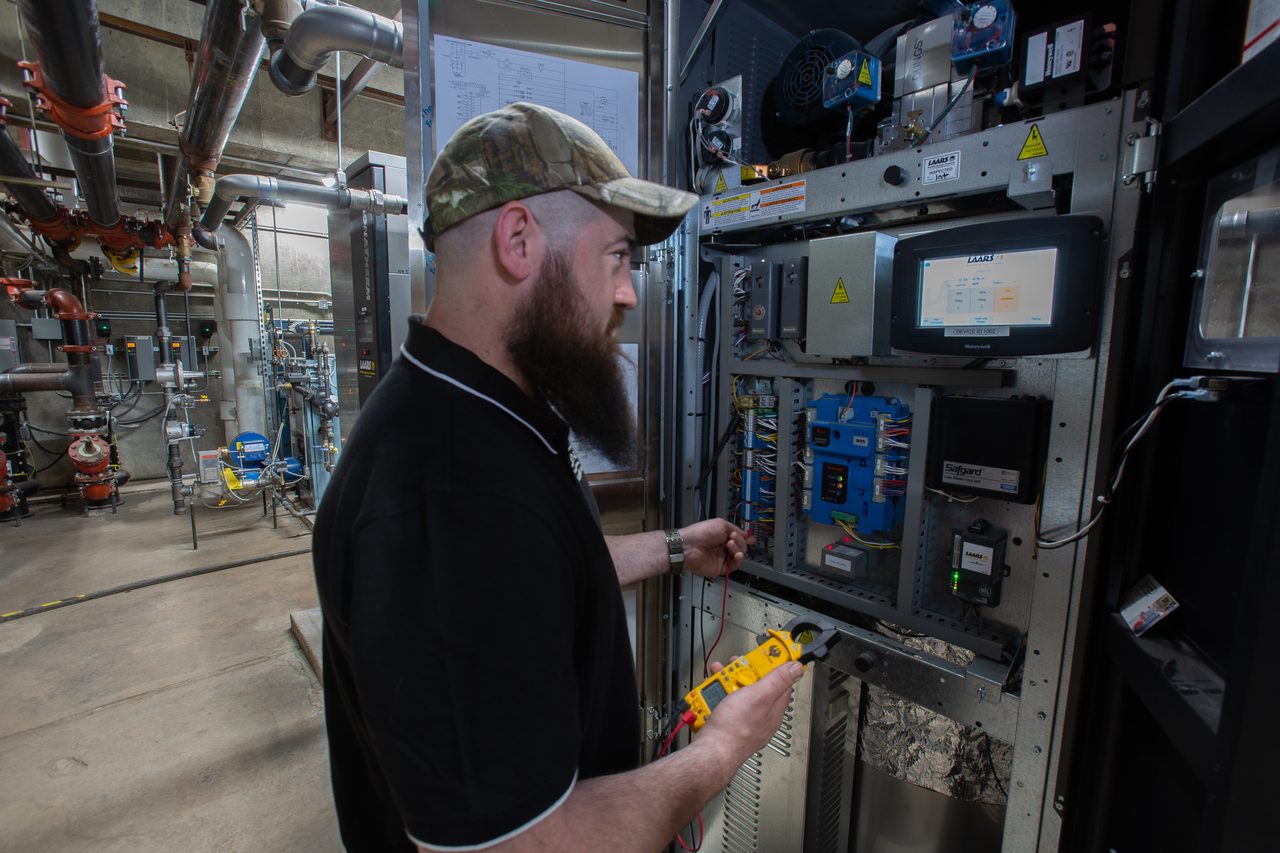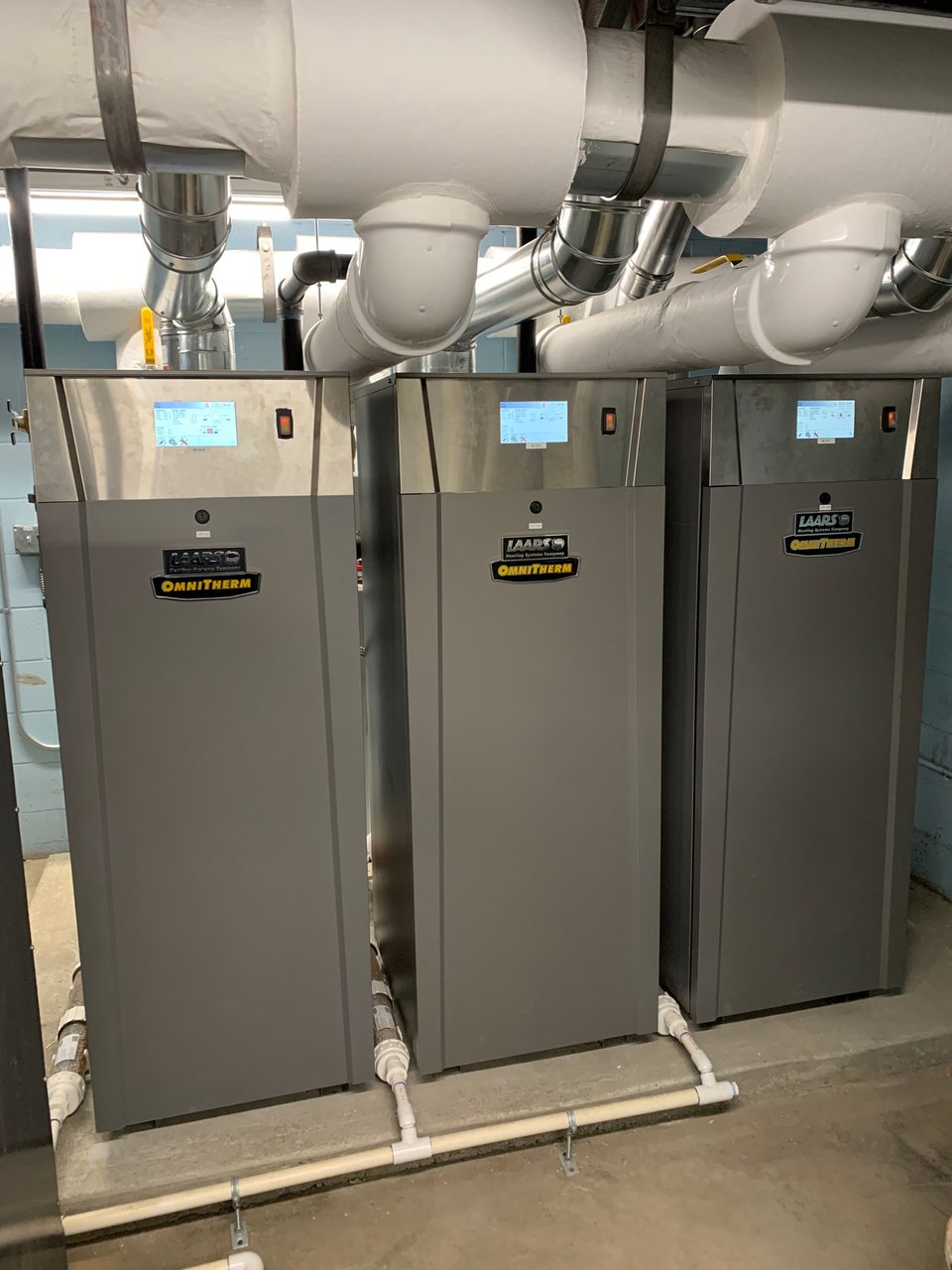Regulations limiting carbon emissions drive efficiency in boiler market
Industry experts weigh in on the latest boiler market trends.
By Nicole Krawcke
Three Navien NFB-C commercial condesnign fire tube boilers are cascaded together.
Plenty of opportunities lie within the U.S. boiler market. According to an August study by Global Market Insights, boiler market revenue is expected to reach $4 billion by 2028. The anticipated growth rate at 4.5 CAGR will be driven by increasingly strict government regulations to limit carbon emissions as well as increased spending to upgrade traditional heating systems in the health care, institutional and industrial sectors.

Several Lochinvar CREST boilers are installed at Greeley High School in Colorado. Photo courtesy of Greg Gibbs of Shamrock Sales.
Efficiency and emissions
John Kopf, product manager — boilers for Navien, notes efficiency is one of the most important design features for both commercial and residential boiler manufacturers.
“The DOE latest minimum efficiency levels for residential boilers became effective after Jan. 15, 2021,” he explains. “These new regulations affect mainly non-condensing boilers with efficiencies below 84 percent AFUE for gas-fired and 86% for oil-fired boilers. The commercial higher efficiency levels are being planned to take effect in January 2023. The gas-fired hot water boilers with heating capacities between 300,000 Btu and 2.5 million Btu will see their thermal efficiency go up to 84%. Boilers with heating capacities above 2.5 million Btu and up to 10 million Btu will see their combustion efficiency set at a minimum 85%. Aside from meeting changing DOE levels, it also contributes to lower operating costs. Many utility rebates focus on higher efficiency products.
“These new higher AFUEs will affect mainly manufacturers producing cast-iron boilers,” Kopf continues. “High-efficiency boiler manufacturers such as Navien have been making equipment that far exceeds the DOE efficiency levels and will be able to comply with any future increased efficiency levels. Another interesting trend that we have seen is the switch from oil to natural gas and propane. This is driven mostly by pricing and also by environmental concerns.”
Kopf also notes there is an increasing need for equipment connectivity and remote access. Not only do homeowners want to control their equipment remotely, but contractors also benefit from being able to diagnose equipment remotely and arrive at the jobsite ready with the proper parts and tools to troubleshoot the boiler. Remote access is even more important for the commercial side, Kopf points out.
“Building managers often have to oversee multiple locations, and the cost of downtime could be much higher than in residential applications,” he explains. “Remote access to equipment is driven by continuing improvements in technology and demand for high-performing buildings. Equipment connectivity, remote access and troubleshooting are becoming part of our daily lives.”
Robert Wiseman, product manager for commercial boilers for Lochinvar, says he has seen a big push for higher efficiency units and more condensing products in the market.
“Decarbonization is really the main driving force right now; it’s pushing the industry toward developing and incorporating new technologies to gain even higher efficiency,” Wiseman says. “With the industry pushing to be more sustainable, we’ve seen a lot of companies, including Lochinvar, work to reduce the carbon footprints of the units they are making. In order to do this, there has been a lot of time devoted to developing smarter combustion technology. This technology removes some of the guesswork and correlates directly with fewer service calls. The fewer times a customer has to touch the unit or call someone out to provide maintenance, the better. We’re aiming for fewer callbacks by putting technology to work.”
“When you look at some of Lochinvar’s newest products, as well as ones we’ve revamped recently, efficiency has played a big role,” adds Dan Rettig, product manager for Lochinvar. “We’re constantly thinking about how we can create new, high-efficiency products, or make small enhancements to our current products to make them more efficient.”
Wiseman notes federal, state and local regulations limiting carbon emissions are definitely making boiler manufacturers think about where the industry is headed and what types of products are being offered.
“Some of the cities, counties and states have goals to reduce their carbon footprint, but they’re not necessarily set on full electrification,” Rettig explains. “If they can implement more high-efficiency boilers than standard efficiency boilers, those products help them reach their emissions reduction goals. Additionally, some commercial installations are required to supply emissions reports, and because of that, they are seeking higher efficiencies.”


A hybrid boiler application combines cast iron durability with condensing efficiency to reduce wasted energy, lower utility costs while extending the life of an existing heating system. This hybrid application features a Weil-McLain Commercial Condensing and Non-Condensing Hybrid Boiler, the SVF 3000 and 1280 Water Boilers.
An office-to-residential construction project converted to a high-efficiency boiler system with the specification of two Stainless Vertical Firetube (SVF) boilers from Weil-McLain.
John Miller, commercial boiler senior product manager with Weil-McLain, agrees that condensing high-efficiency boiler applications continue to grow.
“The market is focusing on advanced boiler and boiler system controls for enhanced efficiency optimization, monitoring and regulatory compliance,” Miller says. “Boiler thermal efficiency is a key design deliverable for new product designs as it is a measure of how efficiently the source fuel is converted into the space or water heating solution. Think of it this way: In an application that has a 95% thermal efficient boiler design, for every $1 invested in natural gas to achieve the heating solution, all but .05 cents is converted into heat. This boiler efficiency coupled with the other boiler system components that require energy (water pumps, etc.) all make up the energy footprint that building managers want to minimize to reduce operating costs and to achieve environmental targets. New minimum efficiency targets impacting the non-condensing boiler market are targeted to go into effect in January 2023 for the U.S. and January 2025 for Canada. Weil-McLain is investing in the future of commercial cast iron with a product portfolio strategy that will cover the full range of existing firing rates 300,000 Btu to 9 million MBH to meet high regulatory requirements.”
Miller notes that minimum low NOx emissions regulations continue to become more popular and stringent in the higher regulated regions on the West coast with more and more emissions regulations appearing in the Southcentral and Southeast markets.
“Large commercial boilers now deploy oxygen trimming systems, or electronic air-to-fuel ratio control, to optimize efficiency,” says Charles O’Donnell, director of marketing for LAARS. “Boiler combustion is continuously monitored and adjusted for ideal performance. We've been adding these technologies to the LAARS commercial product lines such as MagnaTherm and OmniTherm.
Heating system design engineers and building owners are comparing long-term operational costs versus initial installation costs to form their decisions,” he adds. “Boilers that adjust combustion in real-time offer additional long-term operational savings versus traditional combustion systems.”
O’Donnell also notes that state and local environmental policies are the primary driving forces in lower emissions goals.
“We feel that energy efficiency is one of the greatest, most straightforward ways to reduce emissions,” he says. “This means a transition to condensing models where the application can safely accept those products. In addition, we’re seeing an uptick in activity by Air Districts in California that are evaluating lower NOx emission limits. In some areas with aggressive electrification policies, we anticipate they will eventually push toward technologies such as electric boilers and heat pumps, where it will rely on the electric grid that is shifting towards more renewables.”
According to Dongtaek Lee, senior project manager for Bradford White Corp., more manufacturers are introducing fire tube design stainless steel heat exchangers and utilizing cascade systems to meet higher capacity heating demand.
“The lower pressure loss of the fire tube heat exchanger benefits overall system pressure,” he says. “Cascade systems support the continuity of operation and easier maintenance of the cascaded products. At the same time, the cascaded system can achieve a significantly higher turndown ratio, and the smaller physical size of the individual products makes it easy to get into and install in a mechanical room.”
Lee adds that most of the recently launched commercial boilers utilize high-efficiency condensing heat exchangers with pre-mix combustion.
“Low NOx emission products are mostly high-efficiency products,” he says. “And the local requirement for low emissions goals — such as SCAQMD — drives the market to high-efficiency products.”

An egg processing plant utilizes Weil-McLain SlimFit boilers to help ensure a high-quality, efficient process.
Combi-boilers offer a unique solution in certain applications
Combi-boilers are becoming more popular in the commercial space due to recent developments in fire tube heat exchangers and higher Btu on the domestic hot water side, according to Tommy Olsen, product manager — combi-boilers for Navien.
“One of the advantages of using combi-boilers is the ability to replace the hot water tank, and at the same time, extend the lifetime of the equipment,” he says. “Cascading combi-boilers with multiple tankless water heaters provides additional domestic hot water capability for multifamily applications.”
O’Donnell notes that combi-boilers tend to have much smaller heating capacities than most commercial settings require; however, some light commercial applications with smaller heating loads along with a domestic hot water requirement can benefit from these products.
“If only a few units are needed, they can be a space saver,” he says. “However, once the heating load becomes large, combi units do not make as much sense to use based on space, multiple unit piping complexity, etc.”
Rettig notes in commercial applications, multifamily is the primary space where combi-boilers are being applied.
“They utilize space heating and domestic hot water heating, making these spaces a good fit for combi-boilers,” he says. “They not only provide cost savings, but they also take up less room in utility rooms. Because of the limited Btu/h outputs, combi-boilers aren’t a good fit for most large commercial projects.”
Lee agrees, saying combi-boilers may be adequate for some limited commercial applications requiring a small heating demand and a demand for domestic hot water.
“The biggest benefit of combi-boilers is space-saving by smaller footprint comparing with the combination of heating boiler and indirect tank installation,” he says. “However, the selection of the combi-boiler should be carefully made to fulfill the heating demand and the pattern of hot water usage.”

The LAARS MagnaTherm FT Commercial Condensing Fire Tube Boiler features 95% thermal efficiency and a superior firetube stainless steel heat exchanger, which is resistant to corrosive condensate and flue gasses. The long-life design allows for "flexing" of the heat exchanger, reducing stress.
Seeking industry input
When designing new products, many manufacturers turn to the industry for input on what pain points need to be solved.
“There are at least a couple of areas where manufacturers must work very closely with the engineering community,” Kopf notes. “Before the product is developed, manufacturers gather VOC (voice of customer) based on engineering feedback. This is the basis for designing future products and improving existing ones. Once the product is developed and launched, manufacturers assist specifying engineers with selections, specifications and start-ups.”
In a word, relationships with the engineering community are critical, Miller explains.
“As end customer expectations and government regulations continue to advance, so does the need for heating system designs that require complex integrations of heating and control systems technologies,” he says.
Wiseman agrees that engineering input is extremely important for manufacturers. “They’re the ones on the front line, especially on the commercial side. They see what’s going on in their local jurisdictions and they know the specific requirements that are needed now and where they are headed. Engineers are coming back to us and our manufacturers’ reps and telling us what they need. We’re very much listening to the engineering community.”
“Staying engaged with the engineering community and obtaining feedback from those applying the latest in system design is extremely important,” O’Donnell adds. “Idea sharing with experts in the field ensure that what we develop at LAARS is what those designing the next generation of heating systems need.”

LAARS MagnaTherm Boilers feature LAARS Lync technology, a powerful control logic easily managed via icon-driven, touch screen technology. The result is an easy-to-use control system with the intelligence to manage installations from the simple to the complex, the company says.

Three LAARS OmniTherm Boilers were chosen for a retrofit at McClelland Elementary School in Rochester, New Hampshire. The units are able to maintain ideal gas and oxygen levels for increased combustion stability and up to 7:1 turndown ratio. Flexible venting options made for easy installation.
Looking ahead
The efficiency train is a one-way ticket for the boiler market. The trend toward higher efficiency products will only continue to advance.
“The increases in boiler efficiency are driven by consumers’ focus on environmental protection and continuing climate change,” Kopf notes. “With a new administration in office, the minimum boiler efficiencies will continue to go up.”
Olsen notes both the residential and commercial combi-boiler market is headed toward higher domestic hot water capabilities and space heating capacities.
“For boilers and combi-boilers, remote communication capabilities, cascading, improved venting and preemptive troubleshooting are going to become more and more important than ever,” Olsen adds.
The trend towards advanced air-to-fuel ratio combustion control to optimize efficiency and reduce emissions will continue over the coming years, O’Donnell says.
“However, there is a future trend toward the collection of operational data that can be used to take corrective action in the field if necessary,” he explains. “Data tracking can uncover operational irregularities that may indicate the need for maintenance, or other problem resolution. Identifying and fixing issues early can save building owners money over time, and keep units running as environmentally friendly as possible.”
According to Miller, the market will “continue down the path of non-condensing boiler system replacements with tougher minimum efficiency requirements on the horizon with advanced condensing boiler designs achieving greater boiler system efficiency and footprint optimization for new build and boiler system upgrade projects. Boiler system control technology, building automation system integration and monitoring will continue to be targets for market differentiation. Alternates to fossil-fuel heating technologies will also become more common-place.”
Lochinvar continues to evaluate potential industry trends, including alternative energies and higher efficiencies to see what is most relevant and useful for its customers, Rettig notes.
“It’s important to listen and understand what our customers need most,” he says. “We also spend a lot of time listening to the engineers we work with as they can help us determine what is going to be needed in the upcoming years.”
Nicole Krawcke, is chief editor of PM Engineer.

